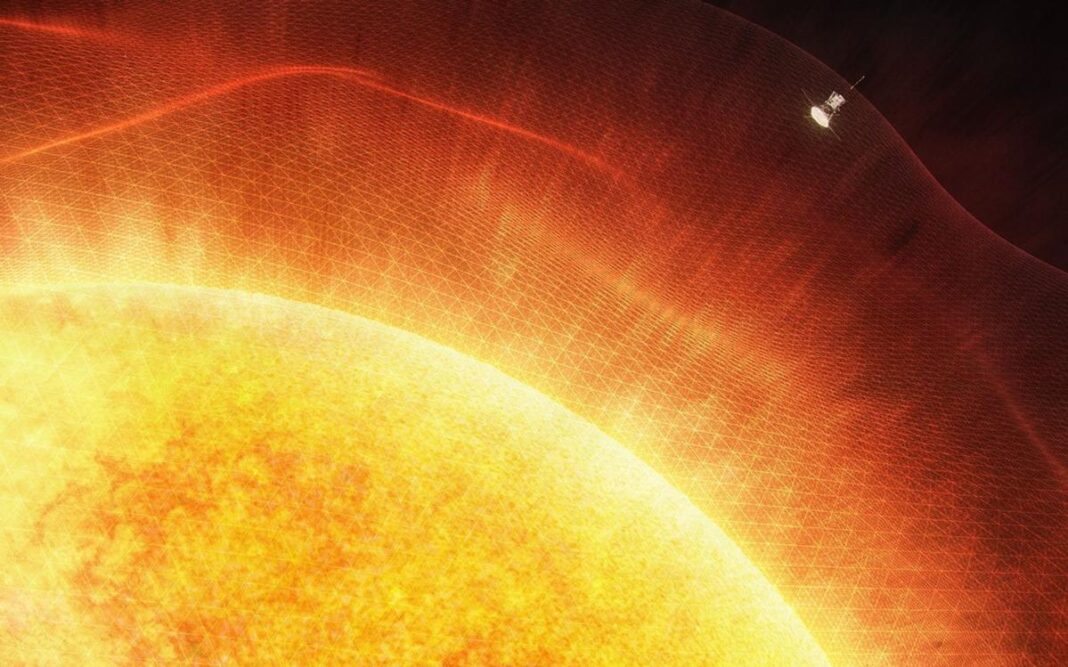Signal from Parker Solar Probe Confirms Successful Close Flyby of the Sun
NASA recently announced that the Parker Solar Probe sent a signal confirming its survival after its closest ever flyby of the sun. This milestone event took the spacecraft within just 3.8 million miles of the sun’s surface, allowing for groundbreaking data collection within the sun’s corona. To put this distance into perspective, if the solar system were scaled down to the length of a football field, the Parker Solar Probe would be merely four yards from the end zone.
The probe’s orbit currently brings it closest to the sun approximately every three months, with two more close flybys scheduled for 2025 on March 22 and June 19. As the probe prepares to transmit the data from its latest approach, Joe Westlake, the director of NASA’s Heliophysics Division, expressed excitement about the fresh insights that will be gained from this unprecedented mission.
The Story So Far:
In a daring journey closer to the sun than ever before, the Parker Solar Probe has embarked on a mission to collect invaluable data within the sun’s corona. This groundbreaking endeavor promises to unveil new discoveries about our closest star and shed light on the mysteries of our solar system.
Full Review:
The Parker Solar Probe’s latest close flyby of the sun marks a significant achievement in space exploration. By venturing into uncharted territory mere million miles from the sun’s surface, the probe has opened doors to a wealth of knowledge about the star that sustains life on Earth. This mission not only showcases cutting-edge technology but also exemplifies humanity’s insatiable curiosity and thirst for discovery.
From the intricate details of the probe’s orbit to the anticipation of the data it will transmit, every aspect of this mission is a testament to human ingenuity and perseverance. The Parker Solar Probe’s journey serves as a reminder of our relentless pursuit of knowledge and the boundless possibilities that lie beyond our planet.
Conclusion:
The successful close flyby of the sun by the Parker Solar Probe represents a significant milestone in space exploration. As we await the transmission of data from this historic mission, we are reminded of the endless possibilities that lie in the vast expanse of space. The insights gained from this endeavor will not only deepen our understanding of the sun but also inspire future generations to reach for the stars.
Frequently Asked Questions:
- What is the significance of the Parker Solar Probe’s close flyby of the sun?
- The Parker Solar Probe’s close flyby of the sun allows for unprecedented data collection within the sun’s corona, providing valuable insights into our closest star.
- How close did the Parker Solar Probe come to the sun during its flyby?
- The Parker Solar Probe approached within just 3.8 million miles of the sun’s surface, marking its closest ever flyby.
- When is the Parker Solar Probe expected to have its next close flyby of the sun?
- The probe is scheduled for two more close flybys in 2025, on March 22 and June 19.
- Who is leading the Parker Solar Probe mission at NASA?
- Joe Westlake, the director of the Heliophysics Division at NASA Headquarters, is overseeing the Parker Solar Probe mission.
- What kind of data is the Parker Solar Probe expected to transmit from its latest flyby?
- The probe is anticipated to provide fresh information about the sun’s corona and the vicinity of a star, offering new insights into solar phenomena.
- How does the Parker Solar Probe’s orbit allow for close flybys of the sun?
- The probe’s orbit is designed to bring it closest to the sun approximately every three months, enabling multiple opportunities for data collection.
- What challenges did the Parker Solar Probe face during its close flyby of the sun?
- The probe had to withstand extreme temperatures and radiation levels near the sun’s surface, showcasing the resilience of its design and technology.
- What are the potential benefits of the Parker Solar Probe mission for future space exploration?
- The data collected by the probe could lead to new discoveries about the sun and enhance our understanding of solar activity, benefiting future space missions and research.
- How does the Parker Solar Probe’s mission contribute to our knowledge of the solar system?
- By venturing close to the sun and collecting data within its corona, the probe offers valuable insights into solar processes that impact the entire solar system.
- What does the success of the Parker Solar Probe’s close flyby mean for the future of space exploration?
- The successful close flyby of the sun by the Parker Solar Probe sets a new standard for space exploration and paves the way for future missions to push the boundaries of our understanding of the universe.
Tags: NASA, Parker Solar Probe, Sun, Space Exploration, Solar System, Data Collection, Heliophysics
- The successful close flyby of the sun by the Parker Solar Probe sets a new standard for space exploration and paves the way for future missions to push the boundaries of our understanding of the universe.

